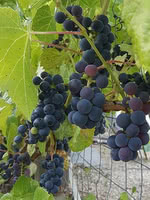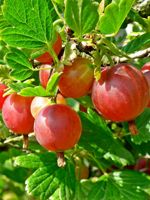Mon-Fri 9am - 5pm Mountain time
Valiant Grape vs Sebastien Gooseberry
Vitis x Valiant
Ribes uva-crispa Sebastien
NOT AVAILABLE THIS SEASON - MIGHT RETURN
NOT AVAILABLE THIS SEASON - MIGHT RETURN
(new stock expected: fall of 2026)
Reported to be one of the hardiest of all grape varieties. This variety will produce bluish red clusters of grapes that are great for jellies and juice. Grapes have long been used to cover arbors and trellises.
This is a self-pollinating variety so only one plant is required to set fruit. Many like this variety for fresh eating as it is similar to concord grapes.
Grapes are a higher maintenance species requiring regular care and pruning. Unchecked and uncared for grapes can spread, be eaten by birds, and have lesser yields.
Applying a thick layer of mulch can help these vines overwinter better.
Note: We do not ship grape vines to BC due to regulatory restrictions from the Canadian Food Inspection Agency.
Sebastien Gooseberry is a nearly thornless variety that produces medium-sized, red gooseberries. When the berries are fully ripe they are quite sweet and great for fresh eating. They can be stored for up to two weeks in the fridge. For baking and preserves, they are often picked when under-ripe when they are firm and tart. The general harvest period is anywhere from July to September.
Sebastien Gooseberry is a Canadian variety that was developed at the Agriculture and Agri-Food Canada research station in Ottawa.
Gooseberries are self-pollinating but planting with another variety will increase yields.
Valiant Grape Quick Facts
Sebastien Gooseberry Quick Facts
Toxicity: leaves are toxic to humans

